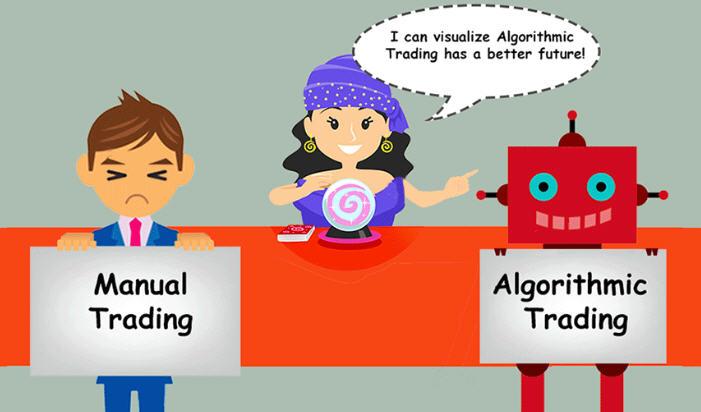Algorithmic vs Manual trading
We are living in the 21st
century which is subtly dynamic and developing every single minute. Artificial
Intelligence has taken over manual activities of human kind. This has a lot to
do with trading reforms in the modern era. Manual trading is over taken by the
so-called Algorithmic trading. Algo trading also known as automated trading
system is a significant reason behind the increased discussion on Algo vs
Manual trading.
There are Tons of Forex trading
robots out there, and almost everyone claims that overnight they can turn small
accounts into huge amount of money.
We are past the point of these
ludicrous statements being believed. We shouldn't allow these EA scams to
steal the authenticity of actual algorithmic trading systems. The reality
is that it can work with automated trading. Highly optimized trading robots are
used by many large investment firms to take money out of the market, so there
is a way of making money using these robots.

Advantages of Algo trading
· It's literally the essence of making a robot trade for
you. It is accurate, perfectly disciplined and makes no mistakes (if programmed
correctly).
· The willingness to be patient and stick to the plan is one of
the greatest issues trader’s face. You can be confident that the robot will be
fully disciplined and adhere to the trading plan you set up by automated
trading, also known as algorithmic trading. It is also the willingness to stick
to the strategy that separates a profitable trader from an unprofitable trader.
· Not only can a robot adhere to the plan and be disciplined,
but proper execution will always be performed by a robot. When it can take a
sale, a robot will not take a purchase.
· The robot can not only trade with better discipline, better
execution, and more range, but a robot is not tired either. The trading robot
will be grinding away at the markets 24 hours a day as you pick the few hours
that fit best for you. That's 3, 4, maybe 10 times the amount traded by a
manual trader on the market.
Alright, alright. The human trader
was sufficiently beaten up. It's time for him to strike back.
The only thing a human forex trader
has is a brain that a robot doesn't. Where a robot can only perform
decisions based on the situations programmed into it, all that is going on can
be taken into account by a person and interpreted together.
Advantages of Manual trading.
· A human being can take into account fundamentals that happen
unexpectedly (like a hurricane in Japan).
· An individual can see that the industry is moving
uncomfortably slow or unreasonably volatile and take out his trades.
· A person can decide whether he has enough profit and when he
feels the momentum can continue in his favour.
· A human being can get a sense of the market—he can get in the
zone.
Examples Algo trading
Let us take example of a trader named
Rahul who uses algorithms while executing trades.
Rahul uses moving averages as
technical measures and only buys a company's stock if the 30-day moving average
stock price goes above the 180-day moving average stock price and similarly
sells the stock when the 30-day moving average stock price goes below the
180-day moving average price.
As a computer program, this
requirement can easily be fed into software.
This Algo will only purchase a
certain number of shares of the given company if the moving average of 30 days
is greater than the moving average of 180 days. For Rahul, the programmed
software will work, as he has specified the program's time, price and volume
with the help of algorithm. Rahul does not need to keep track of
the business opportunities and changes as the algorithm does for him.
Another simple example of Algo
trading
Purchase 100,000 Apple (AAPL) shares
if the price falls below 200. Buy 1,000 shares for every 0.1 per cent rise in
price above 200. Offer 1,000 shares for every 0.1 per cent drop in price below
200.
It
is very common and extremely easy to implement moving average trading
algorithms. The algorithm buys a stock if its current market price is below its
average market price over a certain period of time and sells a stock if its
market price is above its average market price for a certain period of time.
Here we are considering a moving average trading algorithm of 20 days.
Apple Stock price vs 20-days moving
average

The blue line on the graph indicates price and orange line indicates 20-days
moving average.
If
the current market price is less than the 20-day moving average, the algorithm
buys shares of Apple (AAPL) and sells Apple shares if the current market
price is more than the 20-day moving average. The green arrow suggests a point
in time where shares would have been purchased by the algorithm, and the red
arrow reveals a point in time when shares would have been sold by this
algorithm.
Lets look for an example of Manual trading
Mike
is a trend based trader. He searches for openings around the 100-day moving average (MA) to enter
strongly trending stocks, and then uses the 100-day MA for his exit as
well.
As
there is some subjectivity involved when he joins a deal, this includes manual
trading. Subjectivity does not translate so well into an automated program.
Mike for
instance, always likes to see a rising stock fall below the 100-day MA, but
only marginally, and then rise back above the long trade trigger. If he's in
the market, when the price crosses back below the 100-day price, he leaves.